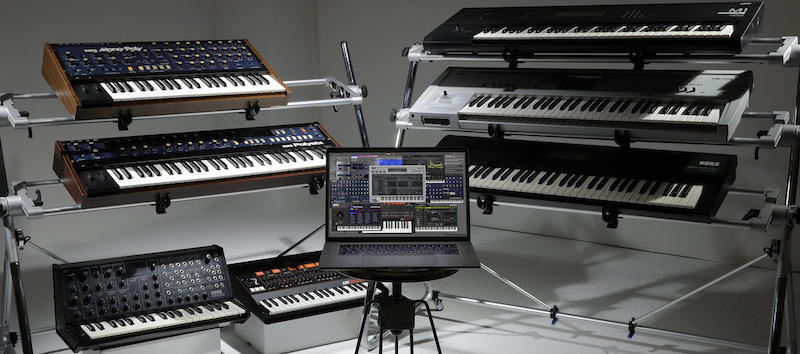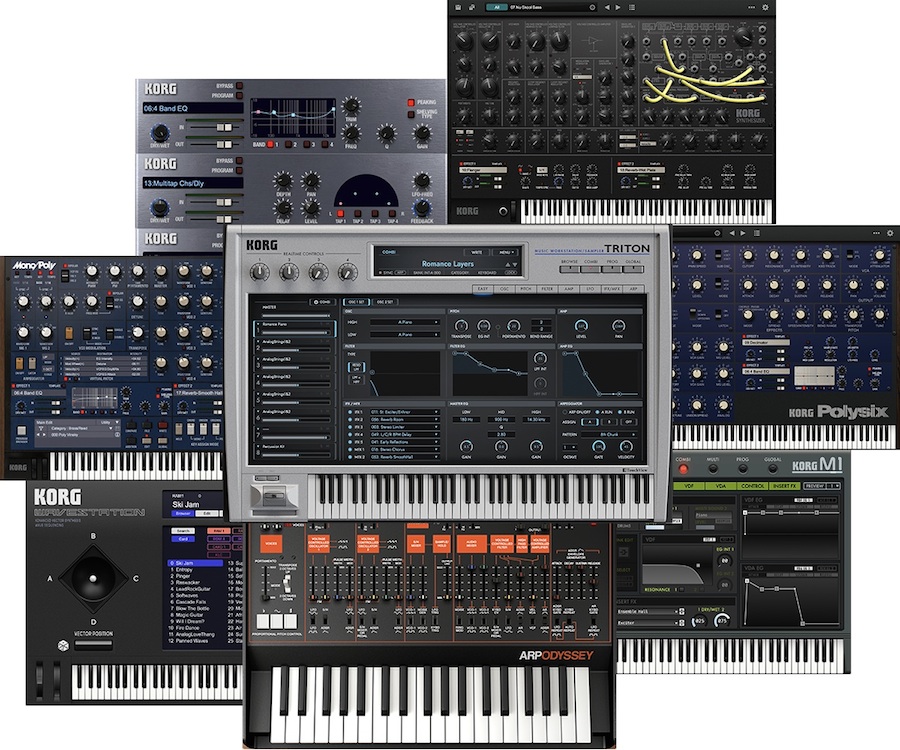New Software Review: Collection 2 Bundle by Korg
It’s been amazing to see so many companies like Roland, U-He, Arturia, and Rob Papen make software emulations of classic analog synthesizers. There’s really never been a better time for producers, keyboardists, and musicians to create with these incredible sounding modern tools that elicit the authentic vibe of hits from decades past.
Korg has been a pioneer in this wave of software emulations, and today I’m excited to dive in and review their Collection 2 suite of plugins to see how they compare to their revered hardware counterparts.
Features
Ever since I first played with an MS-20 in college, Korg has been one of my favorite synthesizer companies. When the iPad software version of that classic synth came out I was very impressed, and now, I am so glad it is available in plugin format so I can use it in my DAW! Along with the MS-20, the Korg Collection 2 also includes the Triton Music Workstation, Arp Odyssey, PolySix, Mono/Poly, M1, Wavestation, and MDE-X Multi Effects Processor. Let’s see how they fare.
Starting with the Arp Odyssey, we can see that Korg has decided to give these plugins features that are not available in the hardware versions. In addition to three filter revisions and the Drive function that were added in Korg’s hardware Arp Odyssey reproduction, they have also added a new polyphonic voice mode that allows you to play up to 16 notes at once, as well as an arpeggiator that can be programmed like a step sequencer. And further, Korg has even included various effects such as a Phaser/Chorus/Flanger, Reverb, and Delay.
Next, the Mono/Poly, MS-20, and PolySix are all similar to the Arp in the sense that they will look familiar to people who have used the hardware. Some of these plugin emulations also include effects not found in the hardware, and some of the synths have iPad versions available for sale—so you can get these classic sounds on your mobile rig, too!
The Wavestation is a synthesizer that combines and shifts complex waveforms to create exciting sounds that evolve over time. The M1 and Triton are fantastic workstations that cover a lot of ground. The Triton offers everything from drums and synths, to strings, brass, and much more; it is probably the most versatile plugin in the collection.
MDE-X is an audio plugin that includes 21 different effects, including DynaComp, Compressor, Multi Band Limiter, Mastering Limiter, Overdrive/Hi Gain + Wah, 4 Band EQ, Exciter/Enhancer, Talking Modulator, Decimator, Flanger, Phaser, PolySix Ensemble, Multitap Chorus/Delay, Stereo/Cross Delay, LCR BPM Delay, Reverb-Hall, Reverb-Smooth Hall, Reverb-Wet Plate, Reverb-Dry Plate, Distortion, and Feedback Reverb.
In Use
As a big fan of the Triton hardware keyboard, I found the plugin did not disappoint; it immediately conjured up some of my favorite 90s keys, drum hits, and more. While a lot of the sounds were very popular in decades past, there are so many presets available that this module can still equally find a place in modern productions. This plugin also includes all of the EXBs that you’d typically have to get as an additional purchase with the physical unit!
The MS-20 plugin sounds fat and rich, just like the hardware. The filter has that classic Korg bite, and while it’s admittedly not as fun to patch virtual cables in a computer, the flexibility of this semi-modular beast makes it easy to come up with unique sounds. The PolySix also retains a lot of the character of the hardware unit, and is very quickly becoming a favorite for pads and aggressive lead sounds.
Similarly, the Arp Odyssey sounds phat! The Rev2 filter is very chunky, and going to preset “010 Knock Bass” added some well-needed pounding thump to a funk track I’ve been working on. The arpeggiator was also incredibly easy to program and made for some really cool cinematic arps in an instant.
LegacyCell may be the most outdated GUI I’ve encountered in a plugin in the last decade, but it still packs a lot of punch and includes a variety of amazing sounding presets. And further, the tweakability is pretty remarkable as the plugin essentially offers the option to layer an MS-20 with a PolySix, or layer one of each with another version of itself.
In practice, I can make a PolySix that has key tracking on the filter so it creates deep rich bass sounds, and then layer it with another PolySix with a brighter pad sound, so when I play open voiced chords, they sound huge. It’s also great that you can access all the knobs on the MS-20 or PolySix within this plugin, but I really wish you could resize the GUI as it’s pretty difficult to read the knobs when designing sounds.
Moving on to the M1, the GUI sees a nice improvement here; I find it a lot easier to navigate presets and modify the sound in this interface. While the hardware version of the M1 came out in 1988, this plugin still sounds pretty appropriate for modern productions. I found the synth pluck sounds are really nice and warm, thanks to the sound of the digital filter. The M1 has a pleasing resonance to its character, which makes pads and lead sounds stand out. For all the fans of this synth, the M1 piano presets really do deliver here, and the plugin also offers a massive 33,000 inspiring presets!
MDE-X V2 is an audio processor that contains 21 interesting effects so, for the sake of time, I’ll only discuss my favorite ones. The DynaCompressor is not subtle, but it is an amazing tool for squashing sounds and placing them upfront in your mixes. I combined it with the M1 piano sounds mentioned above, and found my new favorite EDM/House piano sound.
The Overdrive/Hi Gain + Wah effect was a nice surprise too, as it contains a great-sounding cabinet simulation; testing it out on guitar felt very natural. With the drive turned down and the output turned up, you can get some really nice Twin combo sounds, and then jacking up the drive and switching to Hi-Gain mode can quickly get you to grungy Nirvana-like territory.

The Collection 2 bundle puts the power of all of these classic machines directly at your fingertips.
I found the Exciter/Enhancer to be amazing on full mixes, and a very useful tool for making drums pop. I love that it includes separate left and right delays so you can create pseudo-Haas effects for widening sounds. The very basic EQ-High and EQ-Low can quickly help clear up a muddy sound, and the Reverbs and Delays also have a very pleasing quality to them. There’s a free demo version of the MDE-X (along with the rest of Collection 2) available from Korg, which I’d highly recommend you download and test drive.
And finally, Wavestation—one of the most complex-sounding synths I’ve ever used. Like LegacyCell, the GUI for this one is a bit outdated, but at least it is resizable. With that said, the controls for Wave/Vector sequencing and layering, and the ability to combine waveforms is truly remarkable. I’d still say it’s not an intuitive GUI, as there are so many menus you have to move between to access oscillator, filter, ADSR, and FX settings. But luckily there’s 1,500 presets to get you started on your journey back to the sound of the 90s—an era whose sound was shaped largely by this synth.
To Be Critical
I’m not sure, but it seems like the MS-20, PolySix, and Mono/Poly all sound the same as the iPad versions; I wish Korg added some plugin-only features for this release.
I love the sound of each of these plugins, but I do think the outdated GUIs can be hard to navigate. I think if Korg could update these, I’d feel confident recommending these plugins to all my producer and composer friends.
Summing it Up
If you’re looking for a synth bundle with top-notch sound quality and a massive collection of presets, the Korg Collection 2 may just be the right bundle for you! With so much competition in the synth market these days, Korg really holds their own with this versatile and expansive collection.
The Korg Collection 2 is priced at $399, though it is currently available on sale for $299 (upgrade pricing is also available). And now that it is accessible via Splice’s Rent To Own pricing plan at just $16/month, I’d highly recommend trying it out and seeing if it’s right for you! Regardless of how you may purchase it, this bundle is sure to inspire you to make some great music.
Please note: When you buy products through links on this page, we may earn an affiliate commission.








[…] It’s been amazing to see so many companies like Roland, U-He, Arturia, and Rob Papen make software emulations of classic analog synthesizers. There’s really never been a better time for producers, keyboardists, and musicians to create with these incredible sounding modern tools that elicit the authentic vibe of hits from Read more… […]